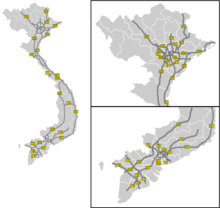Expressways of Vietnam
The Expressway network of Vietnam is a recent addition to the transport network of Vietnam. The first expressways were opened in the mid-2000s, by 2020, the expressway network is expected to stretch 1,276 kilometres (793 mi) and plans are for over 7,000 kilometres (4,300 mi) of expressway by 2030.[1]
| Expressway network of Vietnam | |
|---|---|
 | |
| System information | |
| Length | 1,276 km[1] (793 mi) |
| Highway names | |
Development

Expressways are a rather recent addition to the Vietnamese road network, and standardization has not been fully implemented. Ownership varies by expressway, they are financed, developed, owned and operated by either state-owned or private companies on behalf of the Ministry of Transport.[2] For example, state-owned Vietnam Expressway Corporation owns and exploits four expressways,[3] but toll collection is done by subcontracted companies. The companies exploiting the expressways have to report traffic numbers and toll revenue to the Ministry of Transport and the Directorate for Roads of Vietnam.[4] This construction has been subject of fraud investigations several times, as toll revenue was falsified by the collecting companies in order to take advantage of the difference.[5] The government has also threatened operating companies to revoke their toll collection licence after lack of maintenance caused dangerous situations on several expressways.[6] In 2019 it was reported that the Vietnam Expressway Corporation was $3.7 billion USD in debt, and earning $137 million in revenue each year.[7]
The total cost of the planned expressway network is estimated at $47.9 billion.[8]
In 2020, Minister of Planning and Investment Nguyễn Chí Dũng petitioned to the National Assembly to switch development of the remaining sections of the North–South expressway to state funding instead of build-operate-transfer contracts, in order to avoid delays in raising capital and to reduce interest amount. He noted that Chinese provinces Yunnan and Guangxi built 2,000 kilometres (1,243 mi) of expressways in three years, whereas 1,300 kilometres (808 mi) of planned expressway in Vietnam should have been completed decades ago. If public funding would be approved, construction on the sections Vĩnh Hảo (vi) - Phan Thiet, Mai Son (Ninh Bình) - Highway 45 (Thanh Hóa) and Phan Thiết - Dau Giay (connection to Ho Chi Minh City–Long Thanh–Dau Giay Expressway) would start in 2021.[9]
Expressway use

Generally all cars, buses and trucks are permitted on the expressway but công nông (agricultural vehicles) and most notably all types motorcycles are not.[10]
A minimum speed of 70 kilometres per hour (43 mph) is generally in effect, and the maximum speed is 120 kilometres per hour (75 mph), although sections with a lower maximum speed are common.
List of Expressways
| Number | Name | Length | Notes |
|---|---|---|---|
| North–South expressway | 1,811 kilometres (1,125 mi)[11] | ||
| North–South expressway West | 1,269 kilometres (789 mi)[11] | ||
| Hanoi-Lang Son Expressway | 130 kilometres (81 mi)[8] | Completed between Hanoi and Mai Sao. Will connect to China's | |
| Hanoi-Haiphong Expressway | 106 kilometres (66 mi)[11] | Fully opened | |
| Hanoi-Lao Cai Expressway | 265 kilometres (165 mi)[11] | Connects to China's | |
| Noi Bai–Ha Long-Mong Cai Expressway | 304 kilometres (189 mi)[11] | ||
| Hanoi–Thai Nguyen Expressway | 69 kilometres (43 mi)[11] | Fully completed | |
| Hanoi–Hoa Binh Expressway | 56 kilometres (35 mi)[11] | Completed between Hanoi and QL.21 | |
| Ninh Binh–Hai Phong–Quang Ninh Expressway | 160 kilometres (99 mi)[11] | Completed between Haiphong and Van Don | |
| Hong Linh-Huong Son Expressway | |||
| Cam Lo–Lao Bao expressway | |||
| Quy Nhon-Pleiku Expressway | |||
| Bien Hoa-Vung Tau Expressway | 76 kilometres (47 mi)[11] | Reboot investing | |
| Dau Giay-Dalat Expressway | 209 kilometres (130 mi)[8] | Completed between Lien Khuong and Pass Prenn (Da Lat) | |
| Thu Dau Mot–Chon Thanh Expressway | |||
| Ho Chi Minh City–Moc Bai Expressway | Will connect to Cambodia's Phnom Penh-Bavet Expressway (E4), parallels | ||
| Chau Doc-Can Tho-Soc Trang Expressway | |||
| Ha Tien–Rach Gia–Bac Lieu Expressway | |||
| Can Tho–Ca Mau Expressway | 150 kilometres (93 mi)[8] | ||
| Hanoi Belt 3 | 65 kilometres (40 mi)[11] | Southern ring completed | |
| Hanoi Ring 4 | 136.6 kilometres (84.9 mi)[11] | ||
| Ho Chi Minh City Ring 3 | 97.7 kilometres (60.7 mi)[11] |
See also
Notes
References
- https://en.vietnamplus.vn/vietnam-to-have-more-than-7000km-of-expressways/138150.vnp
- "Da Nang - Quang Ngai Expressway".
- Giang Dang; Low Sui Pheng (18 October 2014). Infrastructure Investments in Developing Economies: The Case of Vietnam. Springer. p. 109. ISBN 978-981-287-248-7.
- "Vietnam Expressway Corporation explains about loss of expressway tolls". VietnamPlus. February 13, 2019.
- "Nine investigated for toll road fraud". vietnamnews.vn.
- "Expressway maintenance failing to keep up". vietnamnews.vn.
- "State-owned expressway builder weighed down by debt". VnExpress International – Latest news, business, travel and analysis from Vietnam.
- Bui Dinh Tuan (September 2013). "Report On Viet Nam Expressway Development Plan" (PDF). Viet Nam Expressway Operation and Maintenance Limited Liability Company.
- "Một tỉnh Trung Quốc 3 năm làm 2.000km cao tốc, Việt Nam 35 năm hơn 400km". Tuổi Trẻ. June 9, 2020.
- "Motorbikes entering expressways in Vietnam could be confiscated". Tuoi Tre News. 27 February 2015.
- "Danh sách các tuyến đường cao tốc Việt Nam hiện nay". Danh sách các tuyến đường cao tốc Việt Nam hiện nay.